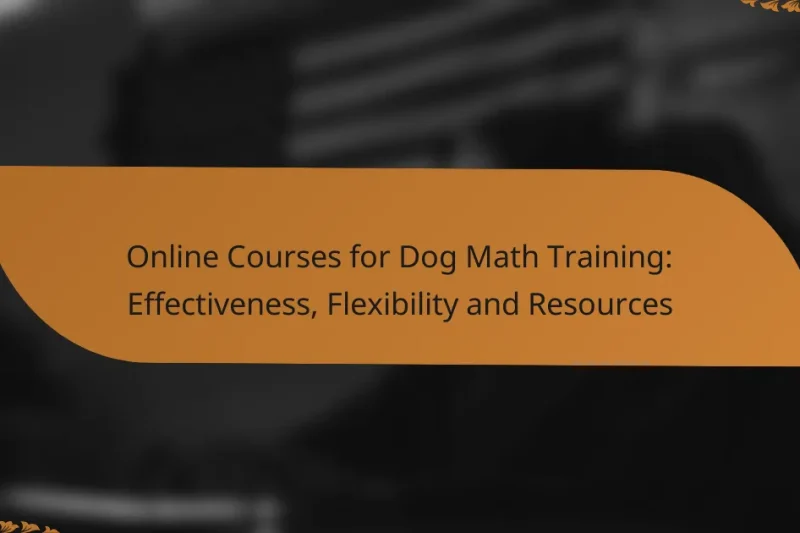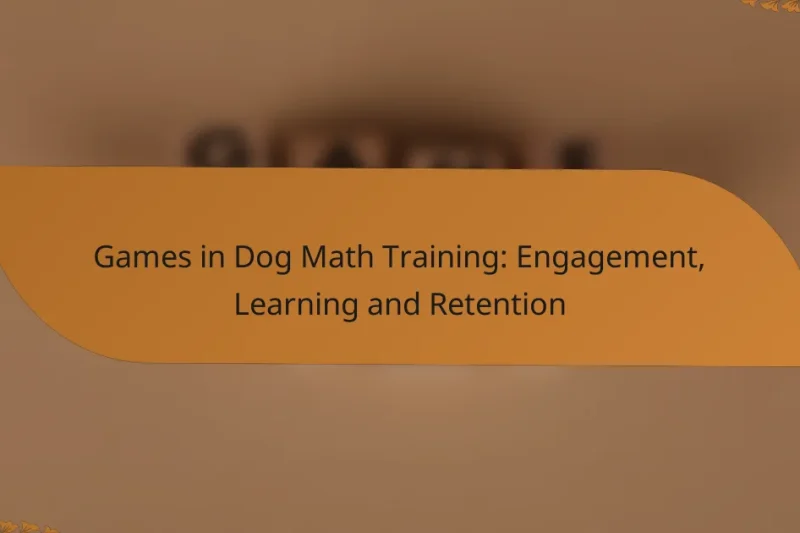Visual aids play a crucial role in enhancing learning by providing clear graphical representations of information, … Visual Aids: Enhancing Learning, Comprehension and RetentionRead more
Effective Training Techniques for Dog Math
Effective training techniques for dog math focus on enhancing a dog’s understanding of numerical concepts through engaging and interactive methods. By utilizing positive reinforcement and structured training tools, owners can create a stimulating environment that encourages cognitive development and strengthens desired behaviors. These approaches not only make learning enjoyable for dogs but also foster a deeper bond between pets and their owners.
Online Courses for Dog Math Training: Effectiveness, Flexibility and Resources
Online courses for dog math training are designed to teach dogs fundamental mathematical concepts through engaging … Online Courses for Dog Math Training: Effectiveness, Flexibility and ResourcesRead more
Games in Dog Math Training: Engagement, Learning and Retention
Incorporating games into dog math training significantly enhances engagement and retention by transforming the learning experience … Games in Dog Math Training: Engagement, Learning and RetentionRead more
What are effective training techniques for dog math?
Effective training techniques for dog math involve methods that enhance a dog’s ability to understand and respond to numerical concepts. These techniques focus on positive reinforcement, structured training tools, and engaging activities that stimulate a dog’s cognitive skills.
Positive reinforcement
Positive reinforcement is a training method that rewards desired behaviors, making it more likely that those behaviors will be repeated. In the context of dog math, this can involve giving treats, praise, or playtime when a dog successfully completes a numerical task, such as counting or identifying quantities.
To implement positive reinforcement, ensure that rewards are immediate and consistent. For example, if your dog correctly identifies the number of treats in a pile, reward them right away to reinforce the behavior. Avoid using negative reinforcement, as it can create anxiety and hinder learning.
Clicker training
Clicker training uses a small device that makes a clicking sound to mark a desired behavior at the exact moment it occurs. This technique is effective for teaching dogs math concepts because it provides clear, immediate feedback. When a dog performs a task correctly, such as selecting the right number of objects, you click and then reward them.
To start clicker training, first, introduce the clicker to your dog by associating the sound with a treat. Gradually, use the clicker to mark behaviors related to math tasks, ensuring to practice regularly to reinforce learning. Keep sessions short, around 5-10 minutes, to maintain your dog’s focus and enthusiasm.
Target training
Target training involves teaching a dog to touch or move towards a specific object or target, which can be used to facilitate learning mathematical concepts. For example, you can use colored mats or numbered objects as targets for your dog to interact with, helping them understand quantities or simple addition.
Begin target training by introducing the target object and encouraging your dog to touch it with their nose or paw. Reward them when they do so. As they become familiar with the concept, you can gradually introduce more complex tasks, such as asking them to touch the target that corresponds to a specific number of treats.
How can I implement positive reinforcement in dog math training?
Positive reinforcement in dog math training involves rewarding your dog for correct responses to encourage learning. This method strengthens the desired behaviors by associating them with positive outcomes, making training more effective and enjoyable for both you and your dog.
Use treats as rewards
Using treats as rewards is one of the most effective ways to reinforce learning during dog math training. Choose small, tasty treats that your dog loves, such as bits of chicken or commercial dog training treats. This will keep your dog motivated and engaged throughout the training sessions.
When your dog successfully performs a math-related task, immediately give them a treat. This helps them make the connection between the behavior and the reward. Aim to reward your dog within a few seconds of the correct response to reinforce the behavior effectively.
Incorporate praise and affection
Praise and affection are essential components of positive reinforcement in dog math training. Verbal affirmations like “good job” or “well done” can boost your dog’s confidence and encourage them to repeat the behavior. Combine these verbal praises with physical affection, such as petting or belly rubs, to create a positive emotional experience.
Be consistent with your praise; use the same phrases and tone each time your dog performs correctly. This consistency helps your dog understand what behaviors are being rewarded. Remember, the goal is to create a supportive environment where your dog feels encouraged to learn and engage with math tasks.
What tools can enhance dog math training?
Using the right tools can significantly improve dog math training by providing interactive and engaging experiences. Training apps and interactive toys are two effective options that can help reinforce learning and keep your dog motivated.
Training apps like Pupford
Training apps such as Pupford offer structured lessons and progress tracking, making them ideal for dog math training. These apps often include video tutorials, quizzes, and gamified elements that encourage consistent practice.
When using training apps, set aside regular time for sessions, ideally ranging from 5 to 15 minutes per day. This keeps the training sessions short and engaging, preventing your dog from losing interest.
Interactive toys for engagement
Interactive toys can stimulate your dog’s mind and reinforce math concepts through play. Toys that require problem-solving, such as puzzle feeders or treat-dispensing toys, can effectively teach basic math skills while keeping your dog entertained.
Consider rotating different types of interactive toys to maintain your dog’s interest. Look for toys that challenge your dog without causing frustration, ensuring they remain motivated to learn and play.
What are common challenges in dog math training?
Common challenges in dog math training include distractions during training sessions and a lack of consistency in teaching methods. These factors can significantly hinder a dog’s ability to learn and retain mathematical concepts.
Distractions during training
Distractions can come from various sources, such as noise, other pets, or even people passing by. These interruptions can make it difficult for dogs to focus on the training task at hand, leading to frustration for both the dog and the trainer.
To minimize distractions, choose a quiet environment for training sessions. Consider using a designated training area where your dog feels comfortable and secure. Gradually introduce distractions once your dog has mastered basic concepts, allowing them to learn how to focus amid varying stimuli.
Lack of consistency
A lack of consistency in commands, rewards, and training schedules can confuse dogs and slow their progress in math training. Dogs thrive on routine and clear expectations, so varying your approach can lead to misunderstandings.
Establish a consistent training schedule and stick to the same commands and rewards for specific behaviors. For example, if you use treats as a reward, ensure they are the same type and size each time. This consistency helps reinforce learning and builds your dog’s confidence in their abilities.
How can I measure progress in dog math training?
Measuring progress in dog math training involves tracking performance over time to identify improvements and areas needing attention. Regular assessments and consistent documentation will help you understand how well your dog is grasping mathematical concepts.
Track performance with a training log
Maintaining a training log is essential for measuring progress in dog math training. Record each session’s date, duration, exercises performed, and your dog’s responses. This log allows you to spot trends, such as consistent successes or recurring challenges.
Consider using a simple table format to organize your log. For example, you might track the number of correct responses, time taken to solve problems, and any distractions encountered. This structured approach makes it easier to analyze your dog’s development.
Use video recordings for review
Video recordings provide a valuable tool for reviewing your dog’s math training sessions. By watching the footage, you can assess your dog’s behavior, focus, and problem-solving strategies in real-time. This method helps identify specific areas where your dog excels or struggles.
When recording, aim for clear angles that capture both your dog’s actions and your training techniques. After reviewing the videos, take notes on what worked well and what needs adjustment. This feedback loop can significantly enhance your training effectiveness.
What prerequisites are needed for effective dog math training?
Effective dog math training requires a foundation in basic obedience and an understanding of canine behavior. These prerequisites ensure that the dog is receptive to learning and can engage with the training process positively.
Basic obedience training
Basic obedience training is essential for establishing a communication framework between the dog and the trainer. Commands such as sit, stay, and come create a structure that helps the dog focus during math training exercises.
Start with short training sessions, ideally lasting 5-10 minutes, to maintain the dog’s attention. Use positive reinforcement techniques, such as treats or praise, to encourage desired behaviors. Consistency is key; practice commands daily to reinforce learning.
Understanding dog behavior
Understanding dog behavior is crucial for tailoring math training to the individual dog’s needs. Recognizing signs of stress or boredom can help trainers adjust their methods to keep the dog engaged and motivated.
Observe your dog’s reactions during training sessions. If the dog seems disinterested or anxious, consider changing the training environment or the type of rewards used. Familiarize yourself with canine body language to better interpret your dog’s feelings and adapt your approach accordingly.
What are advanced techniques for dog math training?
Advanced techniques for dog math training involve engaging your dog in problem-solving tasks and collaborative learning environments. These methods enhance cognitive skills and strengthen the bond between you and your pet, making learning both effective and enjoyable.
Problem-solving exercises
Problem-solving exercises challenge your dog to think critically and find solutions to tasks. These can include puzzles that require your dog to navigate obstacles or find hidden treats. Start with simple tasks and gradually increase complexity to maintain interest and stimulate their mind.
Consider using toys that dispense treats when manipulated correctly, as they encourage exploration and reward persistence. Aim for short sessions of about 10-15 minutes to keep your dog engaged without overwhelming them.
Group training sessions
Group training sessions provide social interaction and can enhance learning through peer influence. Dogs often learn by observing others, making these sessions beneficial for both socialization and skill acquisition. Look for local training clubs or classes that focus on advanced skills.
During group sessions, ensure that the environment is controlled and that all dogs are well-socialized to prevent distractions. Regular participation can help reinforce learned behaviors and create a supportive community for both you and your dog.
How can I adapt training techniques for different dog breeds?
Adapting training techniques for different dog breeds involves understanding their unique temperaments, energy levels, and learning styles. Tailoring your approach can enhance effectiveness and foster a positive training experience.
Consider breed characteristics
Each dog breed has distinct traits that influence their training needs. For example, herding breeds like Border Collies tend to be highly intelligent and energetic, requiring more challenging tasks and frequent mental stimulation. In contrast, breeds such as Bulldogs may be more laid-back and less responsive to intense training sessions.
Adjust training methods
Different breeds respond better to various training methods. Positive reinforcement works well for most dogs, but some breeds may require more structured training sessions. For instance, a stubborn breed like a Shiba Inu might benefit from a combination of positive reinforcement and firm guidance to stay engaged.
Monitor progress and adapt
Regularly assess your dog’s progress and adjust your training techniques accordingly. If a particular method isn’t yielding results, consider switching to a different approach that aligns better with your dog’s breed characteristics. Keeping training sessions short and engaging, typically around 5-10 minutes for puppies, can help maintain focus and enthusiasm.


